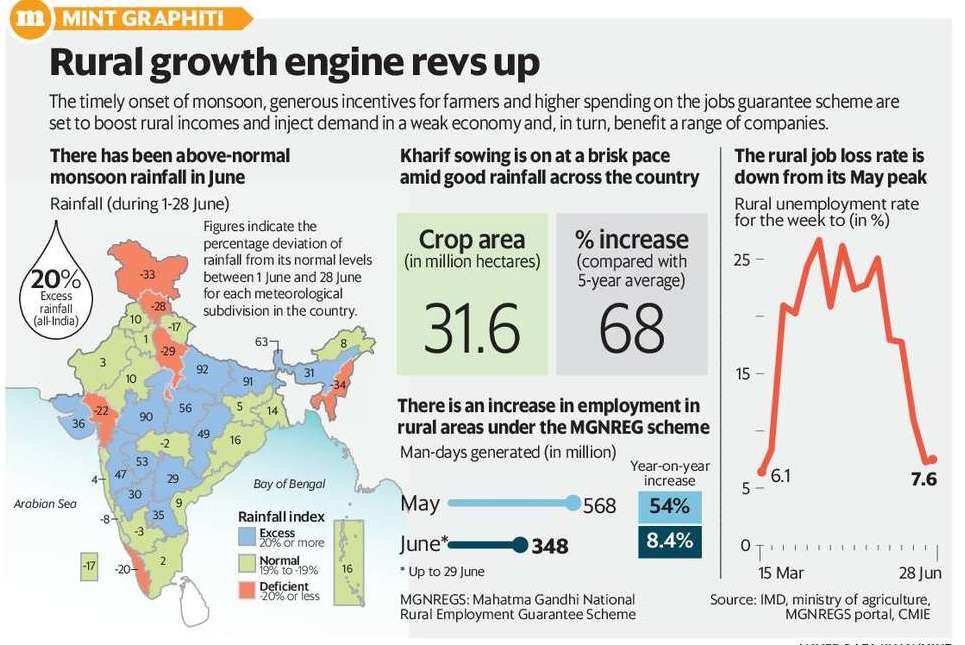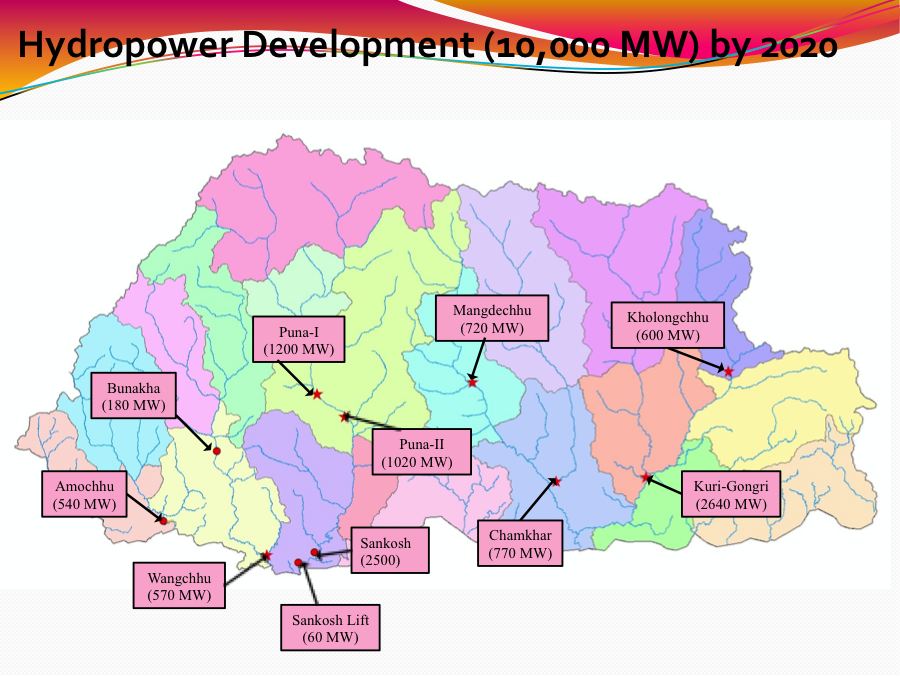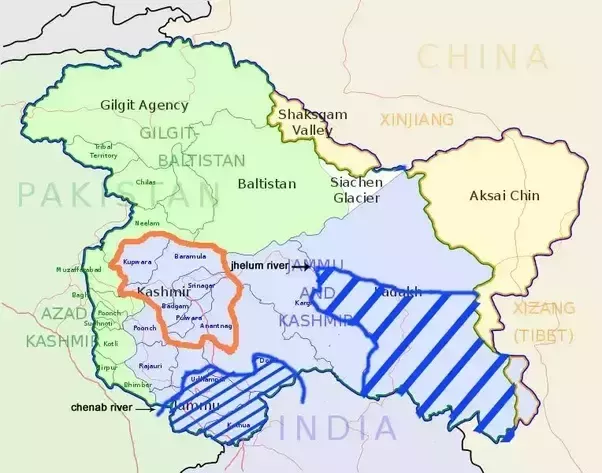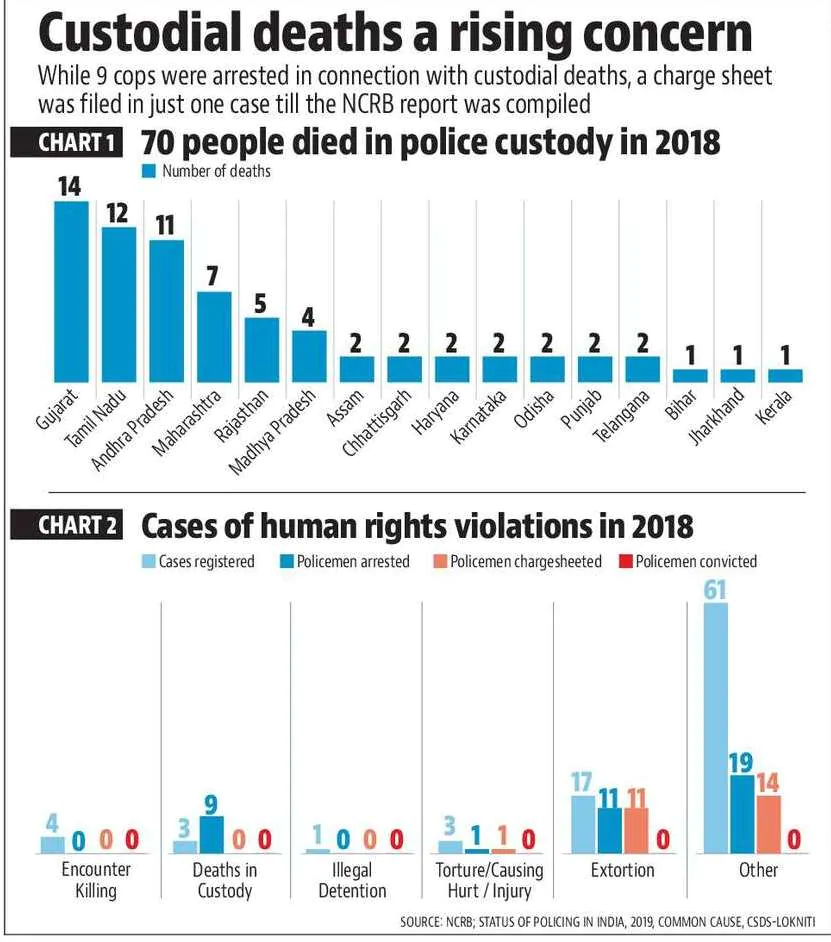Contents
- Rural demand Growth
- India, Bhutan: Kholongchhu project
- Chenab valley terror-free: Govt.
- Survey: Police not trained enough in human rights
- UN declaration delayed over climate text
- Clarify on blacklisting Tablighi Jamaat: Supreme Court
RURAL DEMAND GROWTH
Focus: GS-III Indian Economy
Why in news?
A bumper harvest and high rural incomes have a possibility of driving demand for goods after the coronavirus pandemic stunted growth in the country’s cities.
Expected Rural Demand Rise
- A normal monsoon,
- Record sowing of summer crops,
- Improved winter harvest and
- A raft of government measures to increase rural incomes
are expected to boost demand for goods ranging from two-wheelers to tractors.
- Others that stand to benefit apart from business leaders are consumer durables makers, farm input producers, cement firms and essential goods manufacturers.
- Tractor sales, a bellwether for rural demand, have picked up strongly across rural belts and are headed for a record growth in 2020.
- The Profitability of two-wheeler makers are closely tied to that of the rural economy.
- Demand for packaged foods to improve in rural areas.
- The farm sector accounts for about 15% of India’s GDP.

Conclusion
The resurgence in rural India can help the country partially offset losses suffered by worst-hit sectors such as tourism and aviation.
The share of agriculture in the country’s national income is likely to go up by about 2 percentage points this fiscal.
-Source: Livemint
INDIA, BHUTAN: KHOLONGCHHU PROJECT
Focus: GS-II International Relations
Why in news?
India and Bhutan took a major step forward for the construction of their first hydropower joint venture project in Bhutan’s less developed eastern region of Trashiyangtse.
Details
- The 600 MW Kholongchhu project’s “Concession agreement” was signed and run-of-the-river project is located on the lower course of the Kholongchhu River in Trashiyangtse district in Eastern Bhutan.
- This marks a shift as it is the first time an India-Bhutan hydropower project will be constructed as a 50:50 joint venture, not as a government-to-government agreement.
- The agreement is a “milestone” in the India-Bhutan partnership, under which four hydropower projects have been built in the last 30 years totalling a capacity of 2,100 MW, and another two are under construction.
- The Kholongchhu project is one of four additional projects agreed to in 2008, as a part of India’s commitment to help Bhutan create a total 10,000 MW of installed capacity by 2020.
- Hydro power sector has been the most visible symbol of the mutually beneficial bilateral cooperation between India and Bhutan.
- Progress on preparing the site ground to a halt in 2016 016 over India’s new power tariff guidelines (on Cross Border Trade of Electricity – CBTE), until the government amended its guidelines after negotiations with the Bhutan government.
- Kholongchhu is a continuation of our bilateral cooperation, where Chukha, Kurichhu, Tala and Mangdechhu hydropower projects all stand as proud examples.

-Source: The Hindu
CHENAB VALLEY TERROR-FREE: GOVT.
Focus: GS-III Internal Security Challenges
Why in news?
The J&K police termed the Chenab Valley in Jammu region a militancy-free zone after the killing of three militants in an encounter in south Kashmir’s Anantnag.
Details
- With Masood Ahmad Bhat’s (‘district commander’ of the Hizbul Mujahideen) killing all the militants operating from Doda have been wiped out and the district is now totally militancy free.
- Around 114 militants have been killed in stepped up operations in the Kashmir valley so far in 2020.
Chenab valley

- Chenab Valley, also known as the Chenab Region, is the river valley of the Chenab River flowing through the Kishtwar, Doda, and Ramban districts of Jammu Division in Jammu and Kashmir, India.
- Erstwhile Doda lies between the middle and outer Himalayan range in the Jammu region of Jammu and Kashmir.
- The area is an active seismic zone.
-Source: The Hindu
SURVEY: POLICE NOT TRAINED ENOUGH IN HUMAN RIGHTS
Focus: GS-II Governance
Why in news?
- The custodial deaths of a father and son in Tamil Nadu’s Thoothukudi district has created a nationwide uproar with the family blaming police torture.
- Crime records and survey reports show that violence by police has been reported across the nation, that police personnel are not adequately trained in human rights, and that they have the tendency to inflict punishments outside the judicial process.
Data and Understanding Custodial Deaths
- According to the latest Crime in India report by the National Crime Records Bureau (NCRB), 70 people died in police custody in 2018 – (Highest recorded in Gujrat Followed by Tamil Nadu).
- The numbers increased as in 2019, at least 117 deaths in police custody were reported to National Human Rights Commission (NHRC).
- Studies show that deaths in police custody occur primarily as a result of torture.
- Three in every four died due to alleged torture or foul play, and many died in suspicious circumstances with the police claiming they either committed suicide or died of illness or accident.
- Reports also say that the practice of torturing suspects in police custody to punish them, gather information, extract confessions, or demand bribes, was rampant.

Punishment and training
- NCRB data for 2018 shows that even as 89 cases were registered against police personnel for human rights violations such as custodial killings and illegal detentions, not a single one was convicted of the crime.
- Findings from the Status of Policing in India report showed that the police in India suffers from inadequacies and biases which might lead to such behaviour.
- The report showed that more than 10% police personnel never receive human rights training.
- Even among the personnel who received training in human rights, a majority said it was only at the time of joining the police force.
-Source: Hindustan Times
UN DECLARATION DELAYED OVER CLIMATE TEXT
Focus: GS-II International Relations
Why in news?
U.S. concerns over a paragraph on climate in a UN commemorative declaration have further delayed the statement’s release after tough negotiations successfully resolved previous issues around the text.
Details
- The declaration, celebrating the 75th anniversary of the UN Charter on June 26, was already delayed and countries worked out a compromise around language that some, including India, had objected as being too aligned with Chinese government thought.
- Concerns about the climate-related paragraph was raised by U.S. and the U.S took issue with reference to the Paris Agreement.
- U.K. had written a letter on behalf of India, Canada, Australia, New Zealand and the U.S. objecting to language that was considered too aligned with Chinese government’s ideology.
- There are various solutions to exclude a Member State from a specific point, including a clarificatory reference while presenting the text saying that the statement does not present new legal obligations beyond what is already agreed by states, or a similar reference by the concerned State itself.
Charter of the United Nations (U.N. Charter)
- UN Charter of 1945 is the foundational treaty of the United Nations, an intergovernmental organization.
- The UN Charter articulated a commitment to uphold human rights of citizens and outlined a broad set of principles relating to achieving ‘higher standards of living’, addressing ‘economic, social, health, and related problems,’ and ‘universal respect for, and observance of, human rights and fundamental freedoms for all without distinction as to race, sex, language, or religion.’
- As a charter, it is a constituent treaty, and all members are bound by its articles.
-Source: The Hindu
CLARIFY ON BLACKLISTING TABLIGHI JAMAAT: SUPREME COURT
Focus: GS-II Governance
Why in news?
The Supreme Court asked the Union government to clarify if the blacklisting of 3,500 foreign nationals from 35 countries in connection with the Tablighi Jamaat gathering amid the lockdown was a blanket directive or care was taken to hear and decide the merits of each case individually.
Details
- The Centre had taken decisions by which more than 3,500 foreign nationals were blacklisted for 10 years from travelling to India.
- However, no order has been passed, no notice has been issued.
- The Supreme Court noted that there should be an order first, then only action will follow.
- The SC said that the government order arbitrarily forfeited the personal liberty of more than 960 foreign nationals, belonging to 35 countries, by merely alleging their involvement in ‘Tablighi Jamaat Activities’.
- This order came despite that MHA (the Ministry of Home Affairs) placing no bar on attending religious congregations or visiting religious places.
- It said the sudden blacklisting, apart from registration of FIRs against such foreigners, led to the forfeiture of their passports by State authorities, thereby resulting in a complete deprivation of their personal liberty sans procedure established by law.
Click Here to read more about the Tablighi Jamaat
-Source: The Hindu



